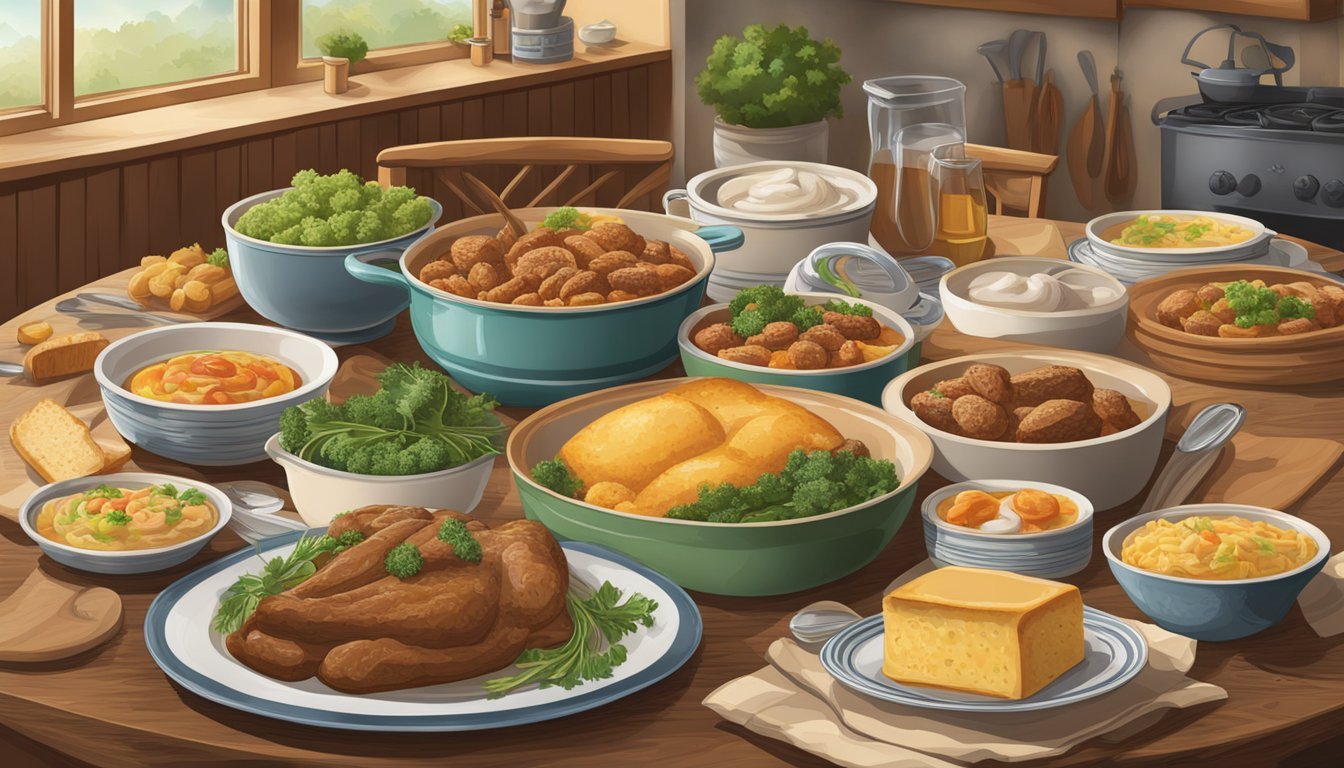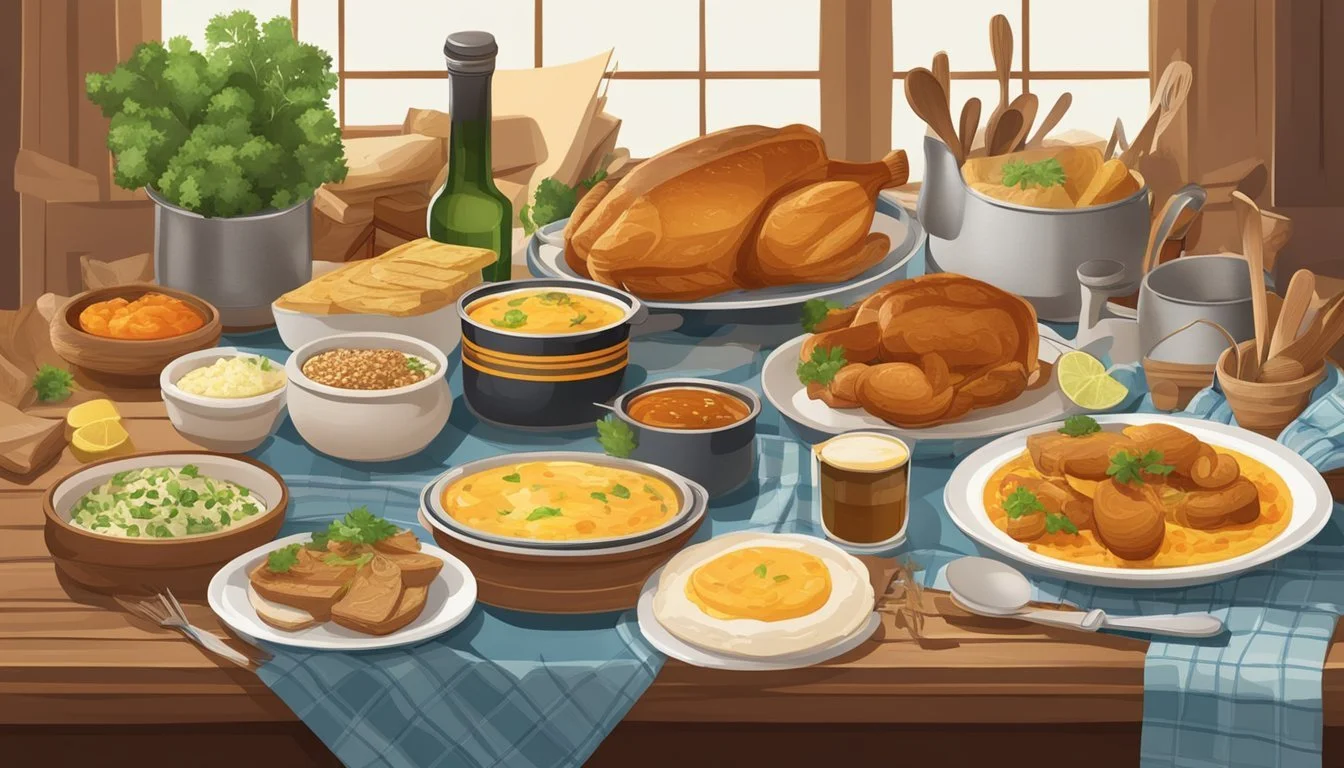The Art of German Texan Home Cooking
A Legacy of Family Recipes
German Texan home cooking is a unique cuisine that has evolved from the blend of traditional German culinary practices and the local ingredients and flavors found in Texas. This culinary fusion has its roots in the 19th century when German immigrants settled in Central Texas. They brought with them a wealth of food traditions, including sausage-making and a penchant for smoked meats (What wine goes well with smoked meats?), which they adapted to their new environment using local ingredients like beef and wild game. Over time, these German techniques were woven into the fabric of Texan cooking, creating a distinctive food culture that is celebrated in family kitchens across the state.
Family recipes play a crucial role in preserving the heritage of German Texan cuisine. These recipes are often passed down through generations, and each dish tells a story of cultural adaptation and culinary ingenuity. The home cooking of this region is known for its robust flavors, often featuring meats such as sausages that highlight the German influence, while side dishes and desserts blend both German and Southern culinary traditions. They are typically hearty, satisfying, and steeped in history, providing not only nourishment but also a connection to German Texan ancestry.
In German Texan households, the art of cooking is a valued tradition that serves as a gathering point for families and communities alike. Festivals such as the Wurstfest in New Braunfels capture the spirit of this cultural fusion, drawing visitors with the promise of authentic flavors and time-honored cooking techniques. From the smoked "Texas hot gut" sausage to the beloved schnitzel adapted to Texan tastes, these dishes are a testament to the enduring legacy of German settlers and their impact on Texas's gastronomic landscape.
Origins of German Texan Cuisine
German Texan cuisine embodies a unique culinary fusion that emerged when German immigrants settled in Texas, integrating their cooking traditions with the local culture.
Influence of German Immigrants
In the 19th century, German immigrants relocated to Central Texas, bringing with them a rich culinary heritage. These European settlers' expertise in sausage making and baking became the cornerstone of German Texan cuisine. They introduced a variety of foods, such as sauerkraut, pretzels, and schnitzel, which were adapted using local ingredients.
Sausages: A cornerstone of German culinary influence, with varieties like bratwurst becoming Texan staples.
Baking: Breads and pastries, including rye bread and strudels, incorporated local flavors.
Integration into Texan Culture
Over time, German culinary traditions merged seamlessly with Texan food culture. This integration was facilitated by the locals' appreciation for the flavors and techniques introduced by the settlers. Smoking and grilling meats, especially the sausages that became synonymous with Texan barbecues, reflect this culinary melding. Dishes that originated from Germany were transformed with a Texan twist, often incorporating flavors from other cultural influences in the state.
Beer: Germans' love for beer brewing contributed to Texan beer culture.
Festivals: Events like Wurstfest highlight the integration of German foods in Texan celebrations.
Fundamentals of German Texan Cooking
German Texan home cooking merges the robust flavors of traditional German cuisine with the local ingredients and tastes of Texas. This fusion has led to a unique culinary tradition that values hearty ingredients, meticulous cooking techniques, and durable cookware.
Essential Ingredients
The cornerstone of German Texan dishes is a combination of staple ingredients that provide the distinctive flavors found in this regional cooking style. Here is a list highlighting the essential ingredients:
Meats: Pork is central, especially in the form of sausages like the Texas hot gut.
Dairy: Milk and buttermilk are commonly used in recipes for added richness.
Vegetables and Herbs: Garlic and onions offer foundational aromatics, while mustard often accompanies meats.
Spices: Salt, black pepper, and paprika are favored for their boldness, alongside other spices to complement the meats.
Fats: Olive oil is used for sautéing and dressings, while lard or bacon fat might be used in more traditional dishes.
Thickeners: Flour is frequently used for making roux and coating meats before frying.
Cooking Techniques
German Texan recipes often involve specific cooking techniques that enhance flavor and texture. A few key techniques include:
Smoking: This method lends a deep, woodsy flavor to meats, especially sausages.
Braising: Slow cooking in a small amount of liquid, often employed for tougher cuts of meat to tenderize them.
Frying: Skillet-frying, using a cast-iron skillet, is a popular technique to achieve a crispy outside while keeping the inside juicy.
Kitchen Equipment
To accurately replicate German Texan dishes, certain kitchen equipment is invaluable. These tools play a pivotal role in traditional German Texan cooking:
Skillets: A cast-iron skillet is a multipurpose tool, ideal for frying and searing.
Sausage Stuffers: For homemade sausage, a sausage stuffer is often used to fill casings evenly.
Smokers: A smoker is essential for imparting the classic smokey flavor to meats.
Mortar and Pestle: This is used to crush and blend spices, including peppercorns and mustard seeds, releasing their full flavors.
Iconic German Texan Dishes
German Texan cuisine represents a unique fusion where hearty German culinary traditions meet Texan flavors. This section explores the iconic dishes that encapsulate the essence of German Texan home cooking.
Meats and Barbecue
German settlers influenced the Texan barbecue scene with their methods of smoking meat. Brisket, a cut once overlooked, became a staple at barbecues, smoked for hours to tender perfection. The sausages, influenced by German techniques, include varieties like beef and veal, linked and seasoned in the German tradition but often smoked with local woods for a Texan twist.
Sausages: Varieties such as bratwurst and kielbasa, smoked to add a distinct Texan flavor.
Beef: Smoked brisket with a spice rub that melds German and Texan tastes.
Ribs: Pork ribs, (What wine goes well with pork ribs?) a crossover from traditional Southern styles, adapted with German seasonings.
Breads and Pastries
German Texan bakeries exhibit a stunning array of bread and pastries. Kolaches—pastries with fruit or meat fillings—are a fixture in these bakeries. On the other hand, the strudel, another German classic, retains its flaky pastry but may include local fruits like pecans and peaches for a regional touch.
Kolaches: Often filled with sweet fruits or savory meats, these pastries are a beloved breakfast staple.
Strudel: Apples or seasonal Texan fruits enveloped in thinly rolled dough, baked until golden.
Sides and Salads
While meats and breads are the stars, sides play a crucial role in German Texan cuisine. Sauerkraut maintains its German roots while occasionally being paired with Texan barbecued meats. (What wine goes well with barbecued meats?) Salads in German Texan cooking often include potato salad served warm, dressed with a bacon vinaigrette, a common practice among German communities.
Sauerkraut: Fermented cabbage that can be a tangy accompaniment to sausages and barbecued meats.
Warm Potato Salad: Potatoes mixed with onions, bacon, and a tangy dressing, differing from the cold mayonnaise-based versions elsewhere in Texas.
Family-Style Meals and Traditions
In German Texan households, food extends beyond sustenance: it is a symbol of heritage and family unity. Recipes passed down through generations grace the family table, while holiday feasts and everyday meals reinforce the fusion of German and Texan culinary traditions.
Holiday and Celebration Foods
During holidays and celebrations, German Texan families often gather to savor dishes that blend Texan flavors with German culinary heritage. A centerpiece of many feasts is a homemade roast chicken, seasoned with a spice blend that nods to both German and Southern palates. Side dishes may include mashed potatoes, carried over from German customs but infused with local Texan twists, such as a dash of chili powder or cheese. For dessert, the Texas sheet cake stands as a beloved confection, enhanced by the addition of German chocolate for an indulgent, crowd-pleasing treat.
Family Recipes for Holidays:
Roast Chicken with Texan-German Spices
Mashed Potatoes with Texan Twists
Texas Sheet Cake with German Chocolate
Everyday Family Recipes
The everyday mealtime at a German Texan home is about simplicity and comfort, echoing the influence of both culinary worlds. Chicken spaghetti, a one-dish meal, often makes an appearance at the dinner table, marrying the convenience of pasta with the hearty addition of chicken and a creamy sauce—a nod to the German love for rich, comforting flavors. Biscuits and gravy stand as a testament to Southern influence, yet many German Texan grandmothers have their unique take on the dish, perhaps by incorporating a touch of nutmeg or using a drier, crumblier biscuit reminiscent of traditional German breads. These family recipes, often not written down but taught hands-on, are regular stars at the family table, with each generation adding their own touch to the classics.
Common Everyday Dishes:
Chicken Spaghetti: Pasta, Chicken, Creamy Sauce
Biscuits and Gravy: with a possible hint of nutmeg to honor German flavors
By maintaining these culinary traditions, German Texan families preserve a sense of identity and history that is served up with every family-style meal.
Modern Interpretations and Fusion
The culinary landscape in Texas is a tapestry of traditions and innovations, where German Texan home cooking is continually being reimagined. Chefs and food enthusiasts in cities like Austin, San Antonio, Houston, and Dallas are mixing time-honored recipes with modern tastes to create new classics.
Contemporary German Texan Fusion
In Central Texas, Austin's vibrant food scene is at the forefront of blending German and Texan flavors. Local grills take pride in serving Texas barbecue with a German twist—think juicy brisket paired with traditional sauerkraut or German potato salad enhanced with Texas-style chili powder. The result is a fusion that respects the integrity of each culinary tradition while creating something entirely new and exciting.
Meanwhile, in San Antonio, German Texan cuisine takes on Latin influences. One can find flour tortillas enveloping succulent cured meats (What wine goes well with cured meats?), elevated by the simple addition of jalapeño or cilantro, providing a cross-cultural taste experience that respects both heritages.
Ingredient Traditional Use Modern Twist Bacon Meat smoking, flavoring Used in creative appetizers and entrees Cilantro Latin garnish Incorporated into German salads and marinades Pinto Beans Tex-Mex staple Complemented with German spices in soups and stews
Influencer and Blogger Contributions
Food bloggers and influencers from regions such as Dallas and South Texas are instrumental in documenting and promoting these fusions. They often cook from scratch, showcasing recipes that mix queso with pineapple for a sweet and savory dip or give a step-by-step guide on making traditional Texan food with a German spin. Through their blogs, they emphasize the use of local ingredients like Seabrook seafood in a way that celebrates both German and Texan culinary identities.
The Texan Twist: A blog focused on the intersection of Texas barbecue and German meat techniques.
Lone Star Sauerkraut: A food influencer who explores the combination of German ferments with Texan dishes.
By chronicling their cooking adventures and family recipes, these influencers not only contribute to the evolving food narrative but also encourage their followers to experiment with German Texan fusion dishes in their own homes.
Preservation of German Texan Culinary Heritage
Preserving the German Texan culinary heritage is at the core of keeping community bonds strong and honoring the history of German migrants in Texas. With deep roots in the region, local communities and documentation efforts play a pivotal role in maintaining these rich culinary traditions.
Local Communities and Events
Community gatherings stand as testimony to the cultural significance that German-influenced Texas cooking holds. Events such as Wurstfest in New Braunfels celebrate over 100,000 visitors through authentic experiences of cuisine and German heritage. Moreover, smaller local festivals and family reunions often showcase traditional dishes like sauerbraten and schnitzels, echoing Texan twists on German classics.
Beyond annual events, weekly farmers' markets and church gatherings frequently feature homemade recipes passed through generations. These venues give a glimpse into the fusion of Czech, as well as German influences, evident in smoked meats and savory pastries that are central to these community interactions.
Cookbooks and Documentation
Cookbooks serve as vital vessels for preserving family recipes and the science behind them, guiding home cooks in replicating traditional dishes. Renowned author Lisa Fain, also known as The Homesick Texan, has contributed significantly through her works, "The Homesick Texan Cookbook" and "The Homesick Texan’s Family Table". These cookbooks document the ways Texan flavors imbue German recipes and the importance of maintaining precise internal temperatures to ensure dishes are cooked to perfection.
Fain's documentation extends beyond mere recipes; it's a narrative that captures the essence of the German Texan home kitchen, thus ensuring that such culinary practices are not lost to time. By keeping track of the historic and evolving culinary techniques, these cookbooks act as custodians of heritage while embracing the science of food that appeals to modern Texas homes.
Resource Guide
In the vibrant landscape of German Texan cuisine, seekers of authentic flavors and cooking wisdom are spoilt for choice. This guide offers a curated selection of venues and opportunities for those looking to immerse themselves in this culinary tradition.
Notable Restaurants and Chefs
San Antonio and Austin are hotspots for German Texan culinary experiences, hosting an array of restaurants where chefs honor their European heritage through a Texan lens.
Otto’s German Bistro (Fredericksburg, TX) - A farm-to-table approach with locally sourced ingredients.
Krause's Cafe (New Braunfels, TX) - Traditional German fare and a biergarten.
Specialty Food Stores and Markets
For home cooks eager to replicate classic German Texan recipes, specialty stores and markets offer a range of authentic ingredients.
Fredericksburg Farms (Fredericksburg, TX) - Known for its jams, sauces, and German-inspired goodies.
Central Market (Multiple locations including Austin, Houston, and Dallas) - Offers a variety of German cheeses, sausages, and bread.
Cooking Classes and Workshops
Cooking classes provide hands-on experience and instruction in crafting German Texan dishes, suitable for varying skill levels.
GTHS Cooks (Austin, TX) - Offers classes for children and plans for adult cooking classes in April/May 2024.
Central Market Cooking School (Multiple locations) - Sometimes features classes on German cuisine adapted to Texan tastes.
Conclusion
The fusion of German and Texan culinary traditions has culminated in a unique and rich home cooking culture. Families across Texas continue to cherish recipes passed down through generations, blending the robust flavors of German cuisine with local Texan ingredients. Smoked sausages, a staple in German-Texan cooking, pay homage to the European settlers' influence while incorporating the distinct smoking and curing techniques adapted to Texas's culinary landscape.
In modern kitchens, the art of German-Texan cooking thrives as cooks prepare Kartoffelpuffer (potato pancakes) and other specialties that reflect the melding of these cultures. Wurstfest in New Braunfels is a testament to these traditions, drawing visitors in the tens of thousands to celebrate and savor German-Texan fare.
Throughout Texas, restaurants and home kitchens alike keep the spirit of hausgemacht—homemade—alive. Recipes like the "Texas hot gut" sausage encapsulate this intersection of cultures, ensuring the continued relevance and appreciation of German-Texan family recipes. In this culinary niche, every dish tells a story of heritage, adaptation, and community—a narrative where food is the heartwarming protagonist.










